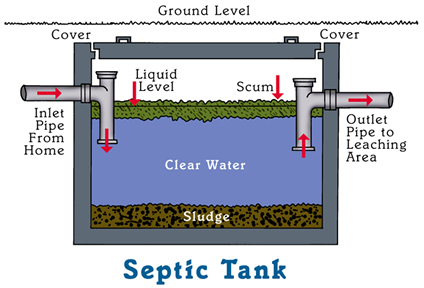There are a number of unforeseen circumstances that could render the need for septic repair. From foul odors and clogged drains to a more substantial crisis like a backyard teeming with sewage, routine septic maintenance will effectively reduce these incidents and prolong the lifespan of your system. To properly recognize a warning sign, it is first important to educate yourself on the biology of your septic system. The construction of your system can be broken down into the following three components.
1. The Septic Tank: You can think of your septic tank as the central hub of your system. Any wastewater that flushes through plumbing via your bathroom, kitchen, or laundry room, will make its debut in your septic tank. The tank separates incoming wastewater to remove solids from floatable materials, such as grease or oil. The solid elements settle to the bottom of the tank where natural bacteria works to decompose the waste. Routine septic pumping is important in the removal of leftover sludge and scum found in your tank.
2. The Drain Field: Liquid waste from the tank is transported into a section of the system called the drain field. The drain field includes a series of perforated pipes, which are responsible for carrying the tank’s pretreated liquid waste and distributing it through the soil to naturally remove contaminants.
3. The Soil: The liquid waste, also known as effluent, filters through the soil for final treatment. The particles in the soil act as a strainer, allowing the drain field to absorb organic matter, while also removing bacteria and viruses. Once the wastewater has been purified, it is released into groundwater or soil where it will eventually evaporate.
Understanding the natural balance of your septic system’s ecosystem will help prevent the need for septic repair in the future. For example, your system’s functionality is heavily dependent upon the soil around the drain field. This soil should be textured in such a way that the water can effectively pass through it for treatment.
Comprehending the inner workings of your system will help you identify any warning signs regarding its operational health. Your local Crosby, Texas septic provider will be readily available for any septic repair needs you may have.







No comments:
Post a Comment